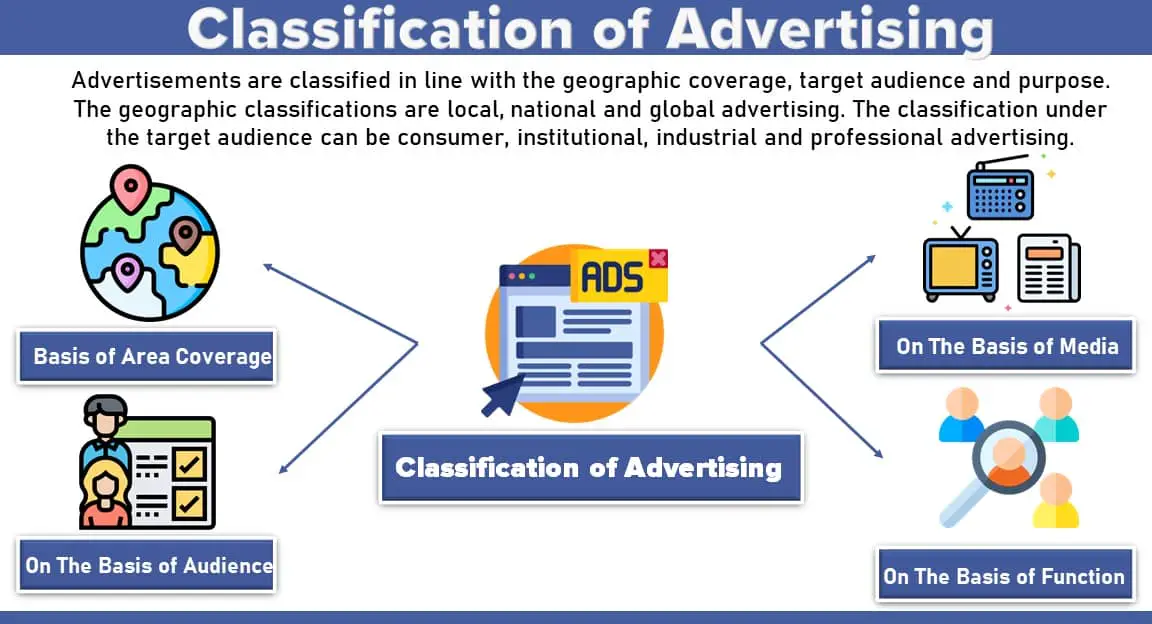Table of Contents
- 1 What are the Classification of Advertising?
- 2 Classification of Advertising
- 3 Classification on The Basis of Area Coverage
- 4 Classification on The Basis of Audience
- 5 Classification on The Basis of Media
- 6 Classification on The Basis of Function
- 7 Classification on The Basis of Advertising Stages
- 8 FAQ Related to Classification of Advertising
- 8.1 What are the 5 Classifications of advertising?
- 8.2 How do you classify the market on the basis of area?
- 8.3 Explained the classification on the basis of audience.
- 8.4 What is the classification of advertising media?
- 8.5 What is the classification on the basis of function?
- 8.6 What is classification on the basis of advertising stages?
What are the Classification of Advertising?
Advertisements are classified in line with the geographic coverage, target audience, and purpose. The geographic classifications are local, national and global advertising. The classification under the target audience can be consumer, institutional, industrial and professional advertising.
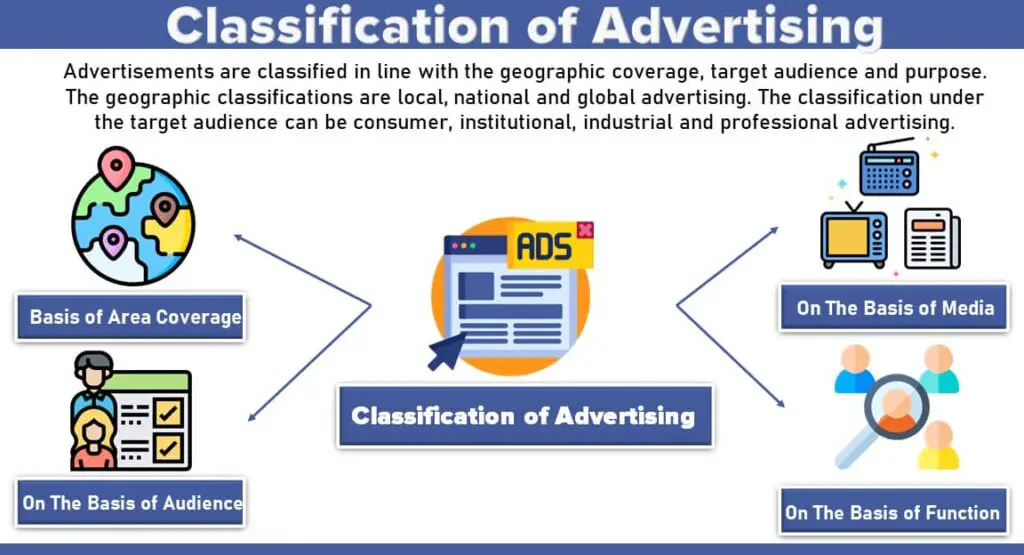
Table of Contents
The purpose of advertising is defined by the nature of the product, service or idea.
Classification of Advertising
Classification of Advertising on various basis. Management scientists have classified advertising on different criteria as follows:
- Classification on The Basis of Area Coverage
- Classification on The Basis of Audience
- Classification on The Basis of Media
- Classification on The Basis of Function
- Classification on The Basis of Advertising Stages

Classification on The Basis of Area Coverage
On this basis of area coverage, advertising may be classified into the following four categories:
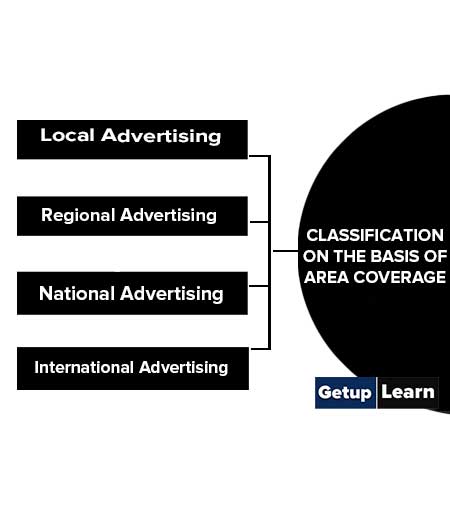
Local Advertising
It is also known as „retail advertising‟. It is undertaken by local retail stores, departmental stores, co-operative stores, selling cloth, saris, and other consumer goods and consumer durables.
It is directed at local customers. Media, used for local advertising, are shop decorations, local newspapers, magazines, posters, pamphlets, hoarding, new signs, local cinema houses, etc.
Regional Advertising
It has wider coverage, as compared to local advertising. It covers a particular region, which may be one state, or, more than one state, the people of which may be having a common tongue, or, use one common product.
It is undertaken by the manufacturer, or, a regional distributor of a product. Media, used for regional advertising, include regional newspapers, magazines, radio, regional T.V., outdoor media, etc. It is considered to be an ideal form of advertising for launching and marketing a new product in a specific region.
National Advertising
It is generally undertaken by manufacturers of branded goods, for which, advertising messages is communicated to consumers all over the country. Almost all possible mass media, including national newspapers, radio, and television networks, are employed for national advertising.
Product services, and ideas, which have been demanded all over the country, are suitable for national advertising. In India, Indian Airline Hindustan Lever Ltd., Vicco, Godrej, Bajaj, and Kirloskar are a few leading advertisers at the national level.
Likewise, detergents, soaps, kinds of toothpaste, cosmetics, scooters, cars, and bicycles, are some of the products, which are advertised all over the country.
International Advertising
This type of advertising is undertaken by those companies, which operate in more than one country, known as „multi-national‟ companies. Exporters, generally advertise their products and services in foreign countries, where ready markets are available.
Air India and other airlines, and multinational companies advertise their products and services all over the world. Coca-Cola and Pepsi are advertised globally, as the sales are almost all over the world. International advertising is extremely expensive, involving the services of professional advertising agencies in different countries.
Classification on The Basis of Audience
On this basis audience, advertising may be classified into the following four categories:
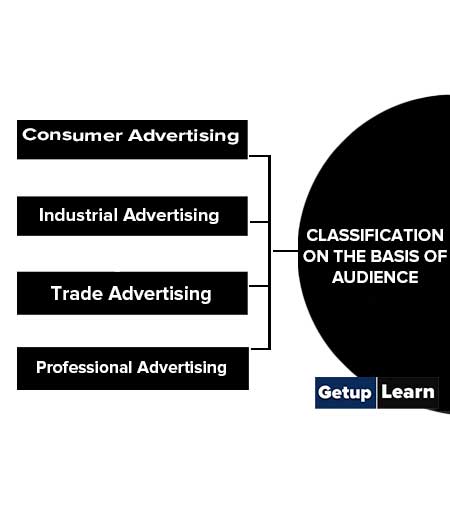
Consumer Advertising
This type of advertising is directed to the ultimate consumers of the consumer products, i.e., the individuals, who buy, or, use the consumer products, or services, say, for example, toilet soap, toothpaste, toothbrush, tea, textiles, etc., for themselves and for their families.
All types of consumer products need continuous and extensive advertising on T.V., radio, and press.
Industrial Advertising
This type of advertising is used by manufacturers and distributors of industrial goods. Such as machinery, plants, types of equipment, spare parts, and components, and are directed at industrial users or customers.
Such advertisements usually appear in trade journals, trade dictionaries, business magazines, and so on. The appeal made is tactual and rational.
Trade Advertising
This kind of advertising is employed by manufacturers and/or distributors to influence and persuade wholesalers and dealers (retailers) to stock and sell the goods of the advertiser by offering incentive schemes to them, or, by inviting dealerships for their particular products(s).
Professional Advertising
It is directed at professionals like doctors, professors, engineers, and others, who are expected to recommend, prescribe, or, specify the advertised products to ultimate consumers. This is done through professional journals and representatives of the advertisers.
Classification on The Basis of Media
On the basis of media, advertising may be-classified into the following four categories:

Print Media Advertising
The print media consists of newspapers, magazines, journals, handbills, etc. No newspaper or, journal, today, can survive without advertising revenue.
Print media advertising, even today, is the most popular form; and revenue derived by mass media from advertising has, therefore, been progressively increasing year after year. Print media appeals only to the sense of sight, i.e. eyes.
Electronic or Broadcast Media Advertising
Electronic, or, broadcast media consists of (i) radio, (ii) television, (iii) motion pictures, (iv) video, and (v) the internet. The radio is audio in nature, appealing only to the sense of sound (ears). Radio advertising is more effective in rural areas, as compared to urban regions.
Television, as an advertising medium, is more attractive and effective because it is an audio-visual medium appealing to both the senses of sight and sound (eyes and ears). Different methods, such as spot announcements, sponsored programs, etc., are used for broadcasting advertising messages.
However, broadcasting media are a very expensive form of advertising. Advertising is also undertaken through movies, videos, and the internet.
Outdoor Media
This includes posters, neon signs, transit, point of purchase (POP), etc. Outdoor advertising can be a good supporting media for other forms of advertising. It is a good form of reminder advertising, especially, POP advertising.
Other Media
This includes direct mail, handbills, calendars, diaries, cinema advertising, the internet, and so on. These miscellaneous media can play an important supporting role to the major media such as television, and newspapers.
Classification on The Basis of Function
Classification on the basis of function which given below:

Direct Action and Indirect Action Advertising: Direct action advertising is undertaken to obtain an immediate response or action on the part of the target audience. Examples include discount sales advertising, sale along with free gift offers, mail-order coupon sales, etc.
The media used is mostly newspapers, and television. Indirect action advertising is undertaken to influence the audience in respect of the advertiser‟s brand. The advertiser expects the target audience to prefer his brand as compared to competitors whenever a buying decision arises in the future.
Primary and Selective Advertising
Primary Advertising is undertaken by trade associations or by cooperative groups. It is undertaken to create generic den1 and for products and services.
For example, the Coffee Board may advertise to consume more coffee. Selective Advertising is undertaken by marketers of branded products. The advertiser intends to create selective demand for his brand. Examples include Pepsi Cola, Coca Cola.
Product and Institutional Advertising
Product or Service advertising is undertaken to promote the sale of products and services branded or unbranded. Institutional advertising is undertaken to build the name and goodwill of the organization. It is also, known as corporate advertising or image advertising. It is mostly undertaken by large firms.
Classification on The Basis of Advertising Stages
On this basis stages, advertising may be classified into the following three different categories:
- Advertising at Pioneering Stage
- Advertising at Competitive Stages
- Advertising at Retentive Stage or Reminder Advertising
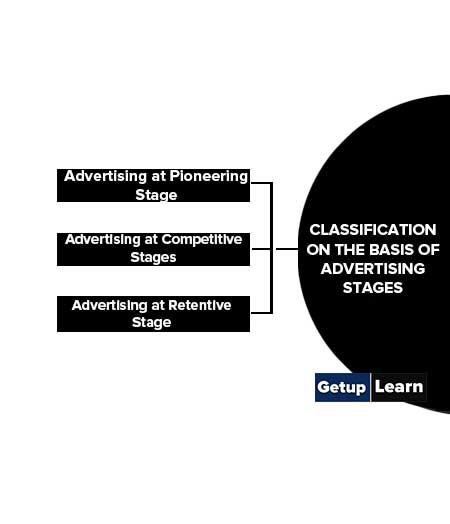
Advertising at Pioneering Stage
Advertising at the „pioneering stage‟ is undertaken to make the audience fully aware of the new brand of a product and to inform, influence, and persuade them to buy, or, use it by highlighting its unique features.
Advertising at Competitive Stages
Once the brand survives the introductory stage, it has, soon faces stiff competition from other well-established brands in the market. At this stage, competitive advertising is undertaken to promote sales effectively.
Advertising at Retentive Stage or Reminder Advertising
When the product has captured a large share of the market, „retentive advertising‟ is undertaken to maintain, or retain the stable position in the market for as long as possible.
Moreover, if the same product is passing through the declining stage in the market, this type of advertising is used to remind the buyers about the product hence, it is also known as „reminder advertising‟.
What are the 5 Classifications of advertising?
Classification of Advertising:
1. Classification on The Basis of Area Coverage
2. Classification on The Basis of Audience
3. Classification on The Basis of Media
4. Classification on The Basis of Function
5. Classification on The Basis of Advertising Stages.
How do you classify the market on the basis of area?
Following are the classification on the basis of area coverage:
1. Local Advertising
2. Regional Advertising
3. National Advertising
4. International Advertising.
Explained the classification on the basis of audience.
Classification on The Basis of Audience:
1. Consumer Advertising
2. Industrial Advertising
3. Trade Advertising
4. Professional Advertising.
What is the classification of advertising media?
These are the examples of classification on the basis of media:
1. Print Media Advertising
2. Electronic or Broadcast Media Advertising
3. Outdoor Media
4. Other Media.
What is the classification on the basis of function?
The following are the classification on the basis of function:
1. Primary and Selective Advertising
2. Product and Institutional Advertising.
What is classification on the basis of advertising stages?
Classification on the Basis of Advertising Stages:
1. Advertising at Pioneering Stage
2. Advertising at Competitive Stages
3. Advertising at Retentive Stage or Reminder Advertising.

